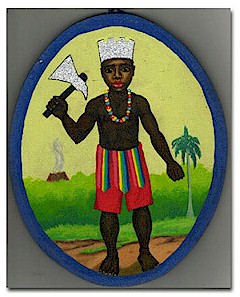Aggayú Solá is a major Orisha that represents the volcano, the magma and the interior of the Earth. He also represents the immense forces and energies of nature, the force of an earthquake, the force of a tidal wave, the force that makes the universe and the earth rotate and many others.
In nature, he is represented by a violent volcanic eruption. When men do not respect the planet, He causes an earthquake. He also represents the deserts, arid lands and rivers that are unleashed. He is the master of fire. It is said that during the process of creating the Earth, he absorbed energy from the bowels of the planet.
History
It is considered that Aggayú Solá is the son of Oroiña, the energy of the foundation. While some say that Aggayu is the father of Chango others think that he is the younger brother to Chango. In Santeria, he is regarded as a protective father who supports and lends strength to a person’s life. This orisha was also a lover to Oshanlá and Yembó.
He is considered a person’s ocha. This orisha has a bellicose temperament and is known for losing his head in heated moments. He is also the ferryman that helps people cross the river. His cult comes from Arará and Fon.
Other spellings: Aganjú, Aganju, Aganyu or Agayu
Greeting: Aggayú Solá Kinigua oggé ibbá eloní!
Number: 9 and its multiples
Colors: Dark Red and White or the 9 colors except Black
Sacred place in nature: The volcano, the edge of the river or the desert
Tools:
Aggayu Sola wields a unique double axe with an anchor-like handle as his tool. His receptacle is a basin of clay or wood painted with nine colors. His attributes include; the oshe (red and white bipedal ax adorned with yellow and blue colors), 9 combats tools, 2 jars of beef 9 mates, kite, snails one hand and a cane.
His elekes are brown (cocoa), matipó, pearl, turquoise blue (blue), a red and sometimes a yellow or green, others are made by interspersing 8 yellow beads, 9 red and 1 white.
Residence:
Some say he lives in the center of the earth. Others think that he lives in rivers. He takes refuge in the palm trees, especially when he encounters difficult situations.
Offerings:
Aggayu has a healthy appetite and enjoys rich food. He likes dried white wine, corn porridge with okra, bananas, mangoes. He loves fruits of different kinds. You can also offer him eggplant, canary seed, corojo butter, biscuits, roasted corn, etc. It is important to note that the offerings are made in groups of 9. For example; 9 eggplants, 9 pancakes, etc….
Animals:
Goat, cock, guinea fowl, jicotea and pigeons. All offerings for Aggayu must be marked through diloggún divination to obtain better results.
Objects of power:
A two-headed axe and a wand.
Appearance:
He is dressed in jacket and trousers of a dark red color. Multicolored scarves are attached to her belt.
Syncretism:
Aggayú Solá is associated with Saint Christopher (July 25), patron of the city of Havana. It is said that Saint Christopher was a giant who helped the baby Jesus cross a river, as in one of the Patakies of Aggayú Solá. In Santiago in Cuba, he is also associated with Saint Michael the Archangel.
Day:
His days are Wednesday and the 16th of each month.
Festive Day:
His holy day is November 16th.
Representation:
He is represented by a boatman in the river.
Children of Aggayu Sola
His sons are violent, irascible, angry and physically very strong. Their anger resembles an erupting volcano. They are also sensitive and appreciate tenderness. These are easy prey for women with fragile appearance because they like to protect the weak.
Dance
Aggayú takes long steps and raises his feet very high, as if walking on obstacles. At the same time, he wields the air with his oche. He likes to carry children on his shoulders.
Aggayu Solá is unique in nature and has no roads although some sources said he has. He teaches us the importance of being strong, steady and level-headed in life, and he supports us through trials and tribulations.
References:
- https://cubanyoruba.blogspot.com/2018/06/aggayu-sola.html
- http://www.cuban-traditions.com/religions/orishas_greater/aggayu_sola/aggayu_sola.html
- https://es.wikipedia.org/wiki/Aggay%C3%BA_sol%C3%A1
- http://santeriachurch.org/the-orishas/aggayu/

